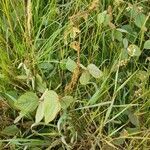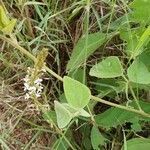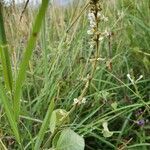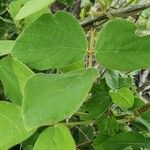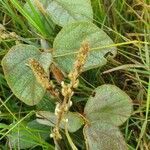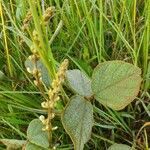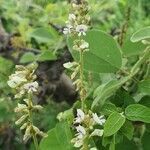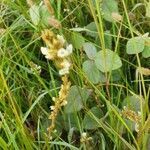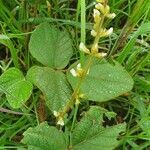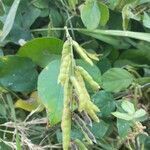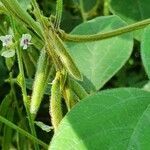A climbing or trailing bean plant. It is a herb that keeps growing from year to year. The stems are woody at the base. Plants can be 4.5 m long. The stems can be covered with rusty hairs. The leaves have 3 leaflets. The leaflets are oval and 2-15 cm long by 1-13 cm wide. They are oval and rounded at the base. They are hairy on both surfaces. The leaf stalks are 2-12 cm long. The flower cluster can have 20 to 150 flowers. The flower standard is reddish blue and can have white patches. The fruit are oblong pods 2-4 cm long and 2-5 mm wide. They can have rusty coloured hairs. The pods are somewhat restricted between the seeds. The seeds are reddish brown and oblong. They are 2-4 mm long and 1.5-2.8 mm wide. They have a finely rough surface.
Leaflets 1.2–15 × 0.5–13 cm, ovate to elliptic, mucronate, glabrous to densely hairy on both surfaces; petiole 2.5–12 cm long; rhachis 2–18 mm long; petiolules 1–3 mm long; stipules 1–10 × 1–3 mm, ovate or oblong-lanceolate.
Standard white, mauve, blue or white with mauve blotch inside, 3–12 × 4–8 mm, obovate, rounded or rhombic; wings and keel white or tinged mauve; wings sometimes with tooth or lobe at junction of blade and claw.
Inflorescence many-flowered, lax or dense; inflorescence axis 2–55 cm long; peduncles 2–10 cm long; pedicels 0.5–3.5 mm long; bracts and bracteoles 1–5 mm long, lanceolate.
Seeds reddish to orange-brown, minutely granular, somewhat compressed, 2–4 × 1–3 × 1–2 mm, with a white funicle remnant.
Pods 1.5–3.5 cm × 2–4 mm, linear, glabrous to densely hairy, somewhat constricted between the seeds.
Calyx sparsely to densely hairy; tube 1–2 mm long; lobes 1–6 mm long, linear-lanceolate.
Perennial trailing or climbing herb often with a woody rootstock.
Stems sparsely to densely hairy.
